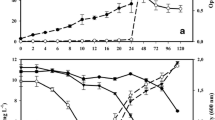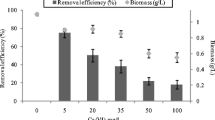Abstract
Indigenous bacteria that are resistant to high concentrations of Cr(VI) were isolated from a Cr-contaminated sediment. Sand column experiments were conducted using the isolated bacteria to investigate microbial effects on Cr(VI) reduction in open systems that simulated subsurface conditions. The indigenous Cr-resistant bacteria appeared to reduce Cr(VI) in the column experiments. When 12 mg/L of Cr(VI) was injected into the columns, the removal efficiencies of Cr(VI) by the isolated bacteria were 39.1%, 62.5%, and 63.6% at 24, 48, and 72 h retention times of Cr(VI) solution, respectively. These results imply that the linear velocity of groundwater or pore water should be less than 0.63 cm/h for effective removal of Cr(VI) in subsurface conditions. In comparison, the noninoculated control column did not show a significant variation in dissolved Cr(VI) concentration. The results indicated that reduction of Cr(VI) was occurring in the column due to the activity of the indigenous bacteria.




Similar content being viewed by others
References
Cheung, K. H., & Gu, J. D. (2003). Reduction of chromate (CrO 2−4 ) by an enrichment consortium and an isolate of marine sulfate-reducing bacteria. Chemosphere, 52, 1523–1529.
Chirwa, E. M., & Wang, Y. T. (1997). Hexavalent chromium reduction by Bacillus sp. in a packed-bed bioreactor. Environmental Science and Technology, 31, 1446–1451.
Daniels, L., Hanson, R. S., & Phillips, J. A. (1994). Chemical analysis. In P. Gerhardt, R. G. E. Murray, W. A. Wood, & N. R. Krieg (Eds.), Methods for general and molecular bacteriology (pp. 512–554). Washington DC: ASM Press.
Francis, C. A., Obraztsova, A. Y., & Tebo, B. M. (2000). Dissimilatory metal reduction by the facultative anaerobe Pantoea agglomerans SP1. Applied and Environmental Microbiology 66, 543–548.
Fukai, R. (1967). Valency state of chromium in seawater. Nature, 213, 901.
Guha, H., Jayachandran, K., & Maurrasse, F. (2001). Kinetics of chromium (VI) reduction by a type strain Shewanella alga under different growth conditions. Environmental Pollution, 115, 209–218.
Guha, H., Jayachandran, K., & Maurrasse, F. (2003). Microbiological reduction of chromium(VI) in presence of pyrolusite-coated sand by Shewanella alga Simidu ATCC 55627 in laboratory column experiments. Chemosphere, 52, 175–183.
Hedgecott, S. (1994). Prioritization and standards for hazardous chemicals. In P. Calow (Ed.), Handbook of ecotoxicology (pp. 378–382). Oxford: Blackwell Scientific.
Lee, S. E., Lee J.-U., Lee J. S., & Chon H. T (2006). Effects of indigenous bacteria on Cr(VI) reduction in Cr-contaminated sediment with industrial wastes. Journal of Geochemical Exploration, 88, 41–44.
Lovley, D. R., & Phillips, E. J. P. (1994). Reduction of chromate by Desulfovibrio vulgaris and its C3 cytochrome. Applied and Environmental Microbiology, 60, 726–728.
Michel, C., Brugna, M., Aubert, C., Bernadac, A., & Bruschi, M. (2001). Enzymatic reduction of chromate: Comparative studies using sulfate-reducing bacteria. Applied Microbiology and Biotechnology, 55, 95–100.
Shen, H., & Wang, Y. (1994). Biological reduction of chromium by E. coli. Journal of Environmental Engineering, 120, 560–572.
Tebo, B. M., & Obraztsova, A. Y. (1998). Sulfate-reducing bacterium grows with Cr(VI), U(VI), Mn(IV), and Fe(III) as electron acceptors. FEMS Microbiology Letters, 162, 193–198.
Acknowledgements
This study was supported by Ministry of Environment and the Korea Institute of Environmental Science and Technology (KIEST) as “The Eco-Technopia 21 Project (2006–04001-0031-0)”.
Author information
Authors and Affiliations
Corresponding author
Rights and permissions
About this article
Cite this article
Lee, SE., Lee, JU., Chon, HT. et al. Microbiological reduction of hexavalent chromium by indigenous chromium-resistant bacteria in sand column experiments. Environ Geochem Health 30, 141–145 (2008). https://doi.org/10.1007/s10653-008-9132-6
Received:
Accepted:
Published:
Issue Date:
DOI: https://doi.org/10.1007/s10653-008-9132-6




